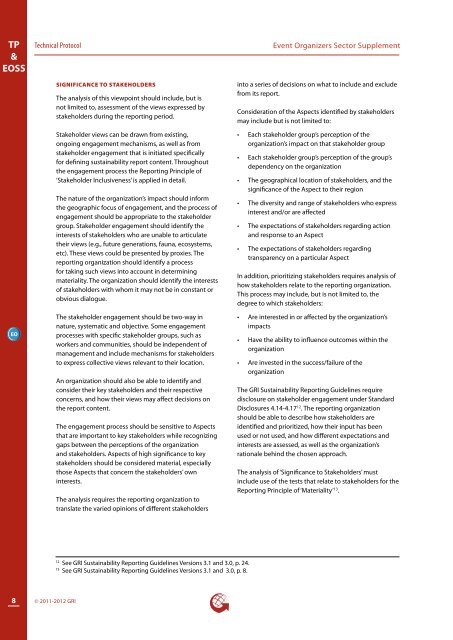Event Organizers Sector Supplement - Global Reporting Initiative
Event Organizers Sector Supplement - Global Reporting Initiative
Event Organizers Sector Supplement - Global Reporting Initiative
Create successful ePaper yourself
Turn your PDF publications into a flip-book with our unique Google optimized e-Paper software.
TP<br />
&<br />
EOSS<br />
EO<br />
Technical Protocol<br />
SIGNIFICANCE to STAKEHOLDERS<br />
The analysis of this viewpoint should include, but is<br />
not limited to, assessment of the views expressed by<br />
stakeholders during the reporting period.<br />
Stakeholder views can be drawn from existing,<br />
ongoing engagement mechanisms, as well as from<br />
stakeholder engagement that is initiated specifically<br />
for defining sustainability report content. Throughout<br />
the engagement process the <strong>Reporting</strong> Principle of<br />
‘Stakeholder Inclusiveness’ is applied in detail.<br />
The nature of the organization’s impact should inform<br />
the geographic focus of engagement, and the process of<br />
engagement should be appropriate to the stakeholder<br />
group. Stakeholder engagement should identify the<br />
interests of stakeholders who are unable to articulate<br />
their views (e.g., future generations, fauna, ecosystems,<br />
etc). These views could be presented by proxies. The<br />
reporting organization should identify a process<br />
for taking such views into account in determining<br />
materiality. The organization should identify the interests<br />
of stakeholders with whom it may not be in constant or<br />
obvious dialogue.<br />
The stakeholder engagement should be two-way in<br />
nature, systematic and objective. Some engagement<br />
processes with specific stakeholder groups, such as<br />
workers and communities, should be independent of<br />
management and include mechanisms for stakeholders<br />
to express collective views relevant to their location.<br />
An organization should also be able to identify and<br />
consider their key stakeholders and their respective<br />
concerns, and how their views may affect decisions on<br />
the report content.<br />
The engagement process should be sensitive to Aspects<br />
that are important to key stakeholders while recognizing<br />
gaps between the perceptions of the organization<br />
and stakeholders. Aspects of high significance to key<br />
stakeholders should be considered material, especially<br />
those Aspects that concern the stakeholders’ own<br />
interests.<br />
The analysis requires the reporting organization to<br />
translate the varied opinions of different stakeholders<br />
<strong>Event</strong> <strong>Organizers</strong> <strong>Sector</strong> <strong>Supplement</strong><br />
into a series of decisions on what to include and exclude<br />
from its report.<br />
Consideration of the Aspects identified by stakeholders<br />
may include but is not limited to:<br />
• Each stakeholder group’s perception of the<br />
organization’s impact on that stakeholder group<br />
• Each stakeholder group’s perception of the group’s<br />
dependency on the organization<br />
• The geographical location of stakeholders, and the<br />
significance of the Aspect to their region<br />
• The diversity and range of stakeholders who express<br />
interest and/or are affected<br />
• The expectations of stakeholders regarding action<br />
and response to an Aspect<br />
• The expectations of stakeholders regarding<br />
transparency on a particular Aspect<br />
In addition, prioritizing stakeholders requires analysis of<br />
how stakeholders relate to the reporting organization.<br />
This process may include, but is not limited to, the<br />
degree to which stakeholders:<br />
• Are interested in or affected by the organization’s<br />
impacts<br />
• Have the ability to influence outcomes within the<br />
organization<br />
• Are invested in the success/failure of the<br />
organization<br />
The GRI Sustainability <strong>Reporting</strong> Guidelines require<br />
disclosure on stakeholder engagement under Standard<br />
Disclosures 4.14-4.17 12 . The reporting organization<br />
should be able to describe how stakeholders are<br />
identified and prioritized, how their input has been<br />
used or not used, and how different expectations and<br />
interests are assessed, as well as the organization’s<br />
rationale behind the chosen approach.<br />
The analysis of ‘Significance to Stakeholders’ must<br />
include use of the tests that relate to stakeholders for the<br />
<strong>Reporting</strong> Principle of ‘Materiality’ 13 .<br />
12<br />
See GRI Sustainability <strong>Reporting</strong> Guidelines Versions 3.1 and 3.0, p. 24.<br />
13<br />
See GRI Sustainability <strong>Reporting</strong> Guidelines Versions 3.1 and 3.0, p. 8.<br />
8<br />
© 2011-2012 GRI

















